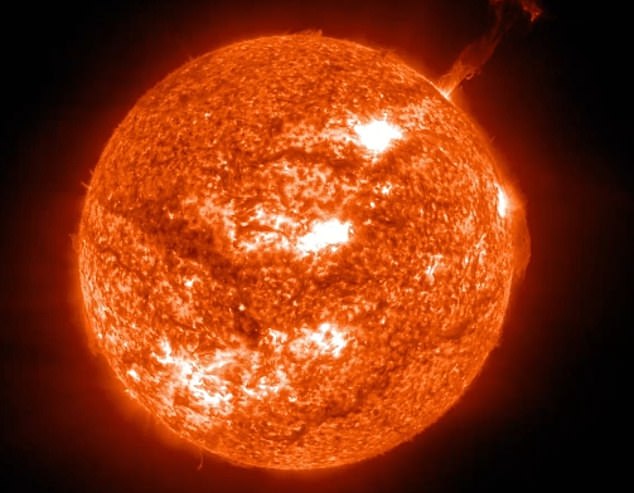A parade of four powerful bursts of solar energy is hurtling toward Earth, raising alarms about potential disruptions to technology and communications.
The National Oceanic and Atmospheric Administration (NOAA) has issued a moderate (G2) geomagnetic storm watch for Thursday, warning that power grids, radio signals and GPS navigation systems could be affected.
Geomagnetic storms occur when the Sun ejects clouds of charged particles, known as coronal mass ejections (CMEs), that collide with Earth’s magnetic field, making it ripple and wobble.
The CMEs were launched from the Sun between October 11 and 13.
Space weather scientist Tamitha Skov said: ‘Storms 2 to 4 arrive starting midday on October 15.’
‘We could be dealing with their effects until early October 17, assuming the sun doesn’t send any more Earth-directed storms,’ she added.
Skov added that the first CME is likely to bring only a ‘mild disturbance,’ but warned that the next three are ‘pancaked together,’ potentially amplifying their effects when they arrive in quick succession.
A weaker (G1) geomagnetic storm could linger into Friday, though its impact is expected to be limited.

The CMEs were launched from the Sun between October 11 and 13.
Skov said on Wednesday that Earth has already been hit by a ‘warm-up pitch’ ahead of the main event, with three additional storms and a surge of fast solar wind still on the way.
Solar activity has been unusually strong this week. The main source is a massive, tangled cluster of dark spots on the sun called Region AR4246.
These sunspots are areas where the sun’s magnetic field is especially active and twisted, which can cause explosions of energy known as solar flares.
This region has already produced several M-class flares, which are mid-level eruptions powerful enough to disrupt radio signals and cause bright auroras on Earth.
One of those flares, an M2.7 flare that erupted on October 13, also launched a CME, a giant cloud of charged particles now speeding toward Earth.
The geomagnetic storm is expected to mainly affect the northern parts of the US.
The northern lights, or aurora, could be visible across the northern and upper Midwest, from New York to Idaho, and possibly including states like Maine, Michigan, Wisconsin, Minnesota, North Dakota, and Montana.
During stronger solar activity, the aurora might be seen slightly farther south, in areas such as Iowa or northern Illinois.

The solar storm will produce stunning Northern lights from New York to Idaho
Power grid effects are expected to be minor and would mostly occur in high-latitude regions, including Alaska and northern US states bordering Canada.
These impacts would likely be limited to small voltage fluctuations rather than widespread outages.
Radio and GPS signals could experience temporary interference, especially at high latitudes and on aircraft or polar flight routes, but effects would be less noticeable farther south.
Scientists found that since 2008, the sun’s solar wind has become stronger, with increases in speed, density, temperature and magnetic field strength.
This increased solar activity could lead to more powerful solar storms, which regularly hit Earth and cause disruptions.
This article was originally published by a www.dailymail.co.uk . Read the Original article here. .

